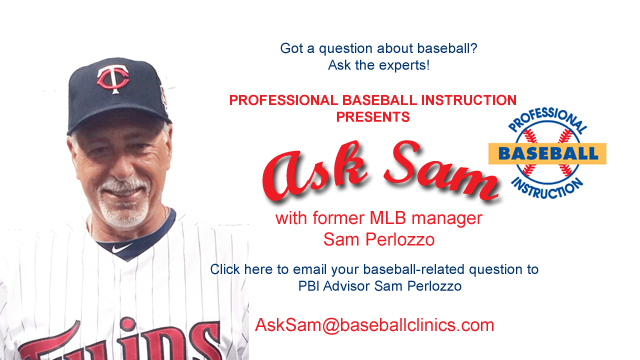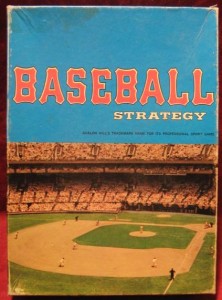
Welcome to the latest “Ask Sam.”
I’m Sam Perlozzo and I’m the minor league infield and baserunning coordinator for the Minnesota Twins. A former manager and coach at the major league level, I am also one of Professional Baseball Instruction’s Major League Advisors. Each month, I answer your baseball-related questions.
 Before we get into this month’s questions, I want to remind you about something brand new that I’m involved in and very excited about. Fellow PBI Advisor Leo Mazzone and I have teamed up with former MLB players Roy Halladay, Dave Magadan, Jody Reed, Tom Foley and others on a new website called Inside Baseball. We offer the world’s largest online library of baseball training videos with proven advice and training methods designed to help baseball players of all abilities improve their game. I hope you’ll take a few moments to check out the website; there’s a lot of excellent information there.
Before we get into this month’s questions, I want to remind you about something brand new that I’m involved in and very excited about. Fellow PBI Advisor Leo Mazzone and I have teamed up with former MLB players Roy Halladay, Dave Magadan, Jody Reed, Tom Foley and others on a new website called Inside Baseball. We offer the world’s largest online library of baseball training videos with proven advice and training methods designed to help baseball players of all abilities improve their game. I hope you’ll take a few moments to check out the website; there’s a lot of excellent information there.
Now, let’s get to your questions. And remember, if you have something you’d like to ask, email me directly – AskSam@baseballclinics.com.
 Q: Sam – In the baseball situation of runners at 1st & 3rd, w/ less than 2 outs, why do some many coaches ask batters to hit a sacrifice fly in this situation, when pop-ups and ground balls are just as likely? I constantly see MLB teams fail to score in this scenario, and it absolutely boggles me! Is the bunt a skill that no one teaches anymore, or is it just too un-manly?! Why not bunt on the 1st base side? Not only will it score the runner from 3rd, but it moves another runner into scoring position at 2nd, and precludes the strong possibility of a double play. This play would, at worst case, ‘cost” less than the sac-fly, and (with a speedy/skilled bunter) might even provide an infield hit. Please help shed light on whatever it is that I am missing here. Perplexed in NC, Bruce
Q: Sam – In the baseball situation of runners at 1st & 3rd, w/ less than 2 outs, why do some many coaches ask batters to hit a sacrifice fly in this situation, when pop-ups and ground balls are just as likely? I constantly see MLB teams fail to score in this scenario, and it absolutely boggles me! Is the bunt a skill that no one teaches anymore, or is it just too un-manly?! Why not bunt on the 1st base side? Not only will it score the runner from 3rd, but it moves another runner into scoring position at 2nd, and precludes the strong possibility of a double play. This play would, at worst case, ‘cost” less than the sac-fly, and (with a speedy/skilled bunter) might even provide an infield hit. Please help shed light on whatever it is that I am missing here. Perplexed in NC, Bruce
A: Bruce, that’s a great question you have there with men on 1st and 3rd. It seems that the game has gone to analytics so much that they have statistics that overrule your train of thought. Don’t get me wrong, I’m not saying what you said is not spot on, but I am telling you that the numbers seem to be saying that bunting in general in not a real productive tool these days. Ive been out of the big leagues for a few years, but have discussed the analytics of the game with other guys who tell me what’s really going on in the Major Leagues these days.
All you have to do is watch some of the moves that you see now. On many occasions, the lineups for the games are now sent down from the front office as suggestions to the manager for him to play and other times it is required that you play their lineup. I wish I could explain it better but the game has changed drastically in the last 5 years or more. They say numbers don’t lie and I believe there is a place for the numbers in the game now. Just look at all the defensive shifts put on now for almost all the players. It’s amazing, and yet the players hit right into the shift!!
There is no question that numbers are playing a significant part of the game. I am probably with you though that some things just aren’t baseball and aren’t that tough. The reality is that part of the game dictates how much you want to use those numbers and the fact that you have a feeling for what you have left on your bench and in your bullpen. The fact remains, get used to i , and pay attention, because a lot of times it works!! Hang in there. Sam

Photo courtesy of USA Today
A: Dave, as far as I know, when a batted ball hits you while running the bases, and you are not on a base, then yes you are out. The only conclusion I can come up with is that the ball didn’t really hit the runner. Unless there is something in the rule book that says if you continue to finish the play, then the play stands. I have never seen that or heard of that so I’m guessing that the umpire didn’t see it hit him or in fact the ball really didn’t hit him either. Sorry, that’s the best I have on that play. Sam

Photo courtesy of ESPN.com
A: LD – as far as the beard being part of the uniform, I doubt that would hold up. Of course we have all seen guys get hit with pitches that grazed their jersey, but only if there is no excessive bagginess to it. I would guess that it would be the discretion of the umpire where a particular player was wearing an exceptionally loose jersey that the umpire could overrule taking your base. As far as I know, they don’t really have a rule that defines excessiveness in uniform or facial hair per se, so the umpire has to have some leeway to make a fair call without a player intentionally on unintentionally making a mockery of the game. Pretty sure that’s a fair recap. Sam
Thanks again for the great questions. I always enjoy talking baseball with people. Send your questions to me via email at AskSam@baseballclinics.com.






If a batter hits a ground ball and the ball hits a base runner running between first and second. The runner is out. My question is how do you score that at bat for the batter is this a hit? or a fielders choice?